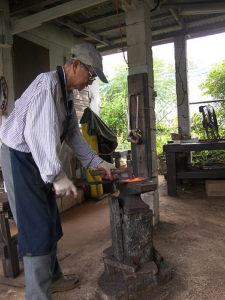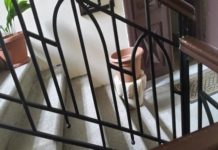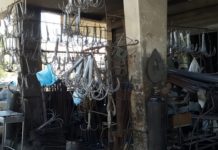Blacksmithing, in the form that it is most known today, has only existed on Guam for a few centuries. On the surface blacksmithing on Guam might appear to be something which was introduced by the Spanish. In reality however, the origins of Chamorro blacksmithing are much more complex and has its roots in indigenous technologies prior to colonisation by the Spanish and the desire of Chamorros to adapt to new introductions and innovations.
The basic equipment that a blacksmith needed were the frågua (forge) in which the metal was heated, and bellows for increasing the intensity of the flame. Mattiyu (hammer), masu (sledge hammer), tinasa (tongs), senset (chisels) and guantes (gloves) were all used at different points in order to shape the metal. Prior to the Spanish colonization, Chamorro utilized guafi in order to help with the shaping of shaping and the creation of holes in shell. As blacksmiths they continued this trend albeit within metal frågua.
 The machete was a status symbol for Chamorros during early US colonisation in the 1930s. The proliferation of Chamorro blacksmiths made the competition over which machete made by which blacksmith was of better quality even more fierce. One test by which the quality of a machete and by extension its maker was measured was to see how well it sang. Tingteng is the word for the noise a well made machete makes after it is hit against something. One common way of testing was to place your fingernail on the edge of the blade and then strum it as if it were a guitar string.
The machete was a status symbol for Chamorros during early US colonisation in the 1930s. The proliferation of Chamorro blacksmiths made the competition over which machete made by which blacksmith was of better quality even more fierce. One test by which the quality of a machete and by extension its maker was measured was to see how well it sang. Tingteng is the word for the noise a well made machete makes after it is hit against something. One common way of testing was to place your fingernail on the edge of the blade and then strum it as if it were a guitar string.
As Chamorros stopped being a people who survived primarily by bartering and subsistence farming, their need for good quality tools ceased as well. Thus tools such as machetes or fosiños, which were once thought of as indispensable to the life of a Chamorro family, were now absorbed into Guam’s new cash economy, where they became just another commodity to be purchased and were made to compete against far cheaper and lower quality imported tools. Those who continued to farm, and those who continued to need the tools that blacksmiths once made, would now turn to hardware stores in order to meet their needs.
As time passed, Chamorro blacksmiths slowly went out of business, due to the high cost of continuing their trade. They did not pass on their skills to subsequent generations, often for lack of interest.
At present there is only one traditional Chamorro blacksmith remaining, Joaquin Flores Lujan, or Tun Jack who is a third generation blacksmith (familian Bittot/Katson). After making a promise to his father soon before his death to keep this tradition alive for future generations, Tun Jack continues to make tools and sell them at his shop in The Chamorro Village in Hagåtña, and has to date trained more than a dozen apprentices.
The social importance of these handmade traditional tools has not been lost however. Items such as fosiños, machetes or kamyo (coconut grater), are no longer necessities, but continue to occupy a special role in Chamorro culture, as gifts and family heirlooms.
Further reading
Benavente, Eddie L.G. I Manmaga’lahi yan I Manma’gas – Geran Chamoru yan Espanot, 1668-1695. N.p.: Eddie L.G. Benavente, 2007.
Carano, P. and P.C. Sanchez. A Complete History of Guam. Rutland, VT: Charles E. Tuttle Co., 1964.
Cunningham, Lawrence J. Ancient Chamorro Society. Honolulu:Bess Press, 1992.
Guam Council on the Arts and Humanities Agency. A Journey with the Masters of Chamorro Tradition. Hagåtña: CAHA, 2000.
Flores, Judy. “Art and Identity in the Mariana Islands: Issues of Reconstructing an Ancient Past.” PhD Thesis, Sainsbury Research Unit, University of East Anglia, Norwich, UK, 1999. Manuscripts are available at the University of Guam Richard F. Taitano Micronesian Area Research Center and at Sainsbury Research Unit, University of East Anglia, Norwich, U.K.
Freycinet, Louis Claude de Saulses de. An Account of the Corvette L’Uraine’s Sojourn at the Mariana Islands, 1819. Translated by Glynn Barratt. Saipan, CNMI: Commonwealth of the Northern Mariana Islands Division of Historic Preservation and the University of Guam Richard F. Taitano Micronesian Area Research Center, 2003.
Political Status Education and Coordinating Commission. Hale-ta – I Manfayi: Who’s Who in Chamorro History. Vol. 1. Hagåtña: Political Status Education and Coordinating Commission, 1995.
Nelson, Evelyn and Frederick Nelson. The Island of Guam: Description and History from a 1934 Perspective. Washington D.C: Ana Publications, 1992.
Russell, Scott. Tiempon I Manmofo’na: Ancient Chamorro Culture and History of the Northern Mariana Islands. Saipan, CNMI: Commonwealth of the Northern Mariana Islands Division of Historic Preservation, 1998.
Vara de Rey y Rubio, Joaquín, Luis Santos Fontordera, and Luis Cadarso y Rey. Reports Concerning the Mariana Islands: The Memorias of 1890-1894. Translated and annotated by Marjorie G. Driver. Mangilao, GU: University of Guam Richard F. Taitano Micronesian Area Research Center, 2000.




